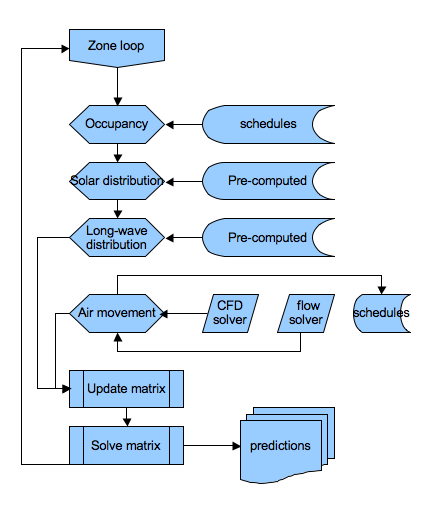Zone and surface energy balances in Models
As with other simulation tools ESP-r resolves the energy balance
within the model at each timestep of an assessment. Various subsystems
such as radiant exchanges are evaluated in order to establish the
energy balance.

Zone energy balance
The energy balance at each thermal zone air node usually resolves to a fraction of a Watt/hr over the assessment period and includes the following heat flux paths (and ):
Surface energy balance
The energy balance at each surface is illustrated by the following two reports. The first is for a partition between two thermal zones and the second is at glazing at the facade. The abbreviations are decoded after the listings.
Causal energy breakdown (Whrs) for pt_general ( 1) in manager ( 1)
Surface is opaque MLC, area= 13.50m^2 & connects to surface 2 in zone 2
Facing manager
Gain Loss
Conductive flux 7194.88 -6531.31
Convective flux 3561.02 -17378.07
Longwave rad inside 1537.74 -9407.29
Longwave rad buildings -- --
Longwave rad sky -- --
Longwave rad ground -- --
Shortwave radiation 15373.45 0.00
Casual Occupt 2542.15 0.00
Casual Lights 1961.09 0.00
Casual Equipt 1210.56 0.00
Casual -- 0.00 0.00
Controled casual gn 0.00 0.00
Heat stored 3012.29 -3076.54
Plant 0.00 0.00
Totals 36393.17 -36393.21
Causal energy breakdown (Whrs) for glazing (10) in manager ( 1)
Surface is trnsp. MLC, area= 5.32m^2 & connects to the outside
Facing manager Facing outside
Gain Loss Gain Loss
Conductive flux 848.39 -124195.24 218313.86 -4.19
Convective flux 32780.88 -3645.09 53.60 -132355.03
Longwave rad inside 80672.84 -952.77 -- --
Longwave rad buildings -- -- 2598.65 -5448.58
Longwave rad sky -- -- 0.00 -103063.62
Longwave rad ground -- -- 6328.35 -5220.84
Shortwave radiation 12494.46 0.00 18886.98 0.00
Casual Occupt 913.73 0.00 -- --
Casual Lights 704.88 0.00 -- --
Casual Equipt 435.11 0.00 -- --
Casual -- 0.00 0.00 -- --
Controled casual gn 0.00 0.00 -- --
Heat stored 2455.38 -2512.53 2770.65 -2860.02
Plant 0.00 0.00 0.00 0.00
Totals 131305.70 -131305.62 248952.09 -248952.30
The flux paths at surfaces include the following:
Air movement contributions
During the solution process the sensible energy impact of air movement is appraised from the mass flows between the zones and ambient conditions as well as the temperature differences (using the last known temperature). If a flow network has been defined it might have iterated to determine the mass flows (which might be dependent on the zone temperatures). If scheduled the flows are imposed.
Solar energy contributions
During the solution process the energy impact of solar radiation is separately resolved. At the outside face of the surface it is based on the current weather data and pre-computed shading patterns (if they exist). At the zone face any pre-computed insolation patterns are imposed on the direct solar radiation prior to iterations of diffuse bounces taking into account the current optical properties of each glazing. Bookkeepping keeps track of solar radiation leaving zones for possible use in adjacent zones at the next timestep.
Sky and ground interactions
Facade interactions with the sky are based on a set of overall view-factors to the ground, sky and other buildings. The current sky temperature is derived from weather data and the radiation exchange is included in the energy balance.
Surfaces in ground contact have a high heat transfer coefficient set by default. Typically the user selects from a list of monthly ground temperature profiles or creates a named profile.
Longwave radiation contributions
During the solution process radiation between surfaces is established via a grey-body approach. If calculated view-factors are available these are used, otherwise an area-emissivity approach is used.
Surface convection contributions
During the solution process convection at surfaces is established via coefficients or correlations directives included in the model description and based on the current temperatures as well as the topology of the surface.
Internal mass contributions
During the solution process internal mass surfaces are treated in exactly the same way as other surfaces associated with the zone. They fully participate in convective, short-wave and long-wave exchanges and the temperature of the layers in these surfaces is resolved in the same way as all other surfaces.
Interactions with environmental controls
During the solution process the energy impact of environmental controls is delivered in the form of an extraction or addition of flux to a specific location. This might be at the air node, a mix of air nodes and surface nodes or to a specific layer within a specific surfaces.
Temperatures derived from the energy balances
After the solution has converged the following temperatures are available for use in other calculation or for recording and user exploration:
Back to top | Back to Welcome page